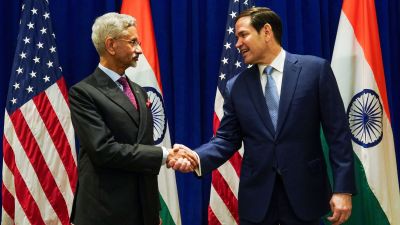India Shining’s shadow is Great Southern Thirst
Babagouda Patil is an old Congress loyalist. ‘‘Those were the golden days,’’ he said of Indira Gandhi’s rule. But o...

Babagouda Patil is an old Congress loyalist. ‘‘Those were the golden days,’’ he said of Indira Gandhi’s rule. But on Tuesday, he didn’t go to hear Sonia Gandhi. As the Congress president made her first visit ever to the nearby town of Chikodi here at the edge of north-western Karnataka, Patil, 45, did what he does—obsessively, his wife said—every day: walking through the drying trunks of his banana trees, bending down to run his hand through the dust-blown soil.
‘‘This land was like gold,’’ muttered Patil, a slight, soft-spoken farmer, his dhoti and Gandhi-topi brown with dust, his face weathered and aged beyond its years. ‘‘For three years, it’s been slowly turning to dust.’’ If the exit polls point to a struggle for Chandrababu Naidu and a tenuous hold for S M Krishna, you can find the reason in the vast, torpid hinterland anywhere outside booming Bangalore and Hyderabad. Across the now-searing plains—whether in Andhra’s naturally arid Rayalseema or Karnataka’s lush Malnad or Kerala’s lusher Waynad—the story that’s escaped metropolitan lives and India Shining is south India’s great dry. And governments in power are paying the price.
In village after village, the land is dust-blown and parched. The numerous lakes that once shimmered and sustained farmers through the summer are bone dry. The rivers have evaporated, and an exodus is underway as the rural economy collapses.
This vast populace—about 200 million—didn’t catch the rosy prediction made on April 15 for a wet 2004, by the men who crunch complex equations on super-fast Cray computers. Nor, for that matter, did the politicians whose fate has already been decided. ‘‘There is zero possibility of another drought year in Karnataka or Kerala,’’ said S K Srivastava, Chief of the Indian Metereological Department from Delhi. ‘‘This year will be green.’’
But it’s a story that goes beyond failed rains. South India’s hinterland may have become a victim of its own larger economic success story, of India Shining, as it were.
You can’t miss the expanding towns and villages, the gaily painted concrete houses, the spread of prosperity. It’s come at a cost, say experts, that politicians and bureaucrats seldom understand: Expanding residential localities with modern plumbing and the spread of industries have sent the groundwater level crashing.
|
The India Shining Dilemma
|
|||||
|
|
|||||
Trees, which serve as sponges, have been cut randomly. An hour east of banana farmer Patil’s farm is Belgaum. North Karnataka’s pensioner paradise suffered the ignominy on April 5 of receiving the first water train in its history from the nearby dam town of Ghataprabha. A permanent pipeline has now been laid from the Ghataprabha left bank canal to the town railway station for the water trains.
Outside Kolhapur, on Maharashtra’s southern border with Karnataka, cotton farmer Siddeshwar Patil refers to the trade-off between water and development, pointing to the discarded stumps of once mighty trees alongside National Highway 4. ‘‘We have seen these trees grow,’’ he said. ‘‘We know they hold water.’’
The problem is there have never been any long-term solutions for the water problem worked into policy or planning. The result is that politicians—battered by voters—have revelled in a numbers blame game. Karnataka Chief Minister S M Krishna and his colleagues repeatedly fume about inadequate special assistance from the Centre.
The BJP in turn said drought relief allocated was just not used. ‘‘We asked for Rs 4,440 crore, but only got Rs 770 crore,’’ complained Congress spokesman V R Sudharshan.
For states like Karnataka, with one of India’s largest rain-fed agricultural areas, the rain predicted by the Met will be a huge relief. Only, the next drought may be closer than they think.
Photos


- 01
- 02
- 03
- 04
- 05





























